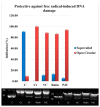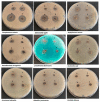Antioxidant, Anti-Inflammatory, Antimicrobial, and Anticancer Activities of Pomegranate Juice Concentrate
- PMID: 37375613
- PMCID: PMC10301233
- DOI: 10.3390/nu15122709
Antioxidant, Anti-Inflammatory, Antimicrobial, and Anticancer Activities of Pomegranate Juice Concentrate
Abstract
Pomegranate juice concentrate (PJC) is a rich source of polyphenols, which exhibit significant antioxidant activity and potential health benefits for disease prevention and therapy. In this study, the polyphenolic profile of PJC was investigated for the first time, and it was found that PJC can inhibit oxidative damage to bovine serum albumin (BSA) and deoxyribonucleic acid (DNA), as well as acetylcholinesterase, α-amylase, and tyrosinase activities. The primary polyphenols identified in PJC were 4-Hydroxy-3-Methoxybenzoate, epicatechin, catechin, rutin, ferulic acid, P-coumaric acid, and cinnamic acid. Additionally, PJC demonstrated potent antibacterial effects against human pathogens such as Streptococcus mutans and Aeromonas hydrophila and dose-dependently reduced the proliferation of colorectal, breast, and hepatic cancer cells via apoptosis. Furthermore, PJC blocked B-cell lymphoma 2 (BCl-2) and the expression of a potent cyclin-dependent kinase inhibitor (P21) and enhanced tumor protein (P53) expression, compared to both untreated cells and cells treated with fluoropyrimidine 5-fluorouracil (5-FU). As a result, PJC may be a beneficial ingredient in the formulation of emerging natural-compound-based chemotherapy and functional foods and could be utilized by the food, nutraceutical, and pharmaceutical industries.
Keywords: DNA and protein damage; antibacterial; anticancer; enzyme inhibition; functional food; nutraceutical; pomegranate juice concentrate.
Conflict of interest statement
The authors declare no conflict of interest.
Figures











References
-
- İncedayi B. Bazı Nar Ürünlerinin Antioksidan Özellikler ve In-Vitro Biyoerişilebilirlik Açısından Değerlendirilmesi. Balıkesir Üniversitesi Fen Bilim. Enstitüsü Derg. 2020;23:96–110. doi: 10.25092/baunfbed.829863. - DOI
-
- Hijazi A., Pisano I., Illek P., Leahy J.J. A Rapid HPLC Method for the Simultaneous Determination of Organic Acids and Furans: Food Applications. Beverages. 2022;8:6. doi: 10.3390/beverages8010006. - DOI
-
- Bou Dargham M., Matar Boumosleh J., Farhat A., Abdelkhalek S., Bou-Maroun E., El Hosry L. Antioxidant and Anti-Diabetic Activities in Commercial and Homemade Pomegranate Molasses in Lebanon. Food Biosci. 2022;46:101540. doi: 10.1016/j.fbio.2021.101540. - DOI
-
- Dandachi F., Hamadeh B., Youssef H., Chahine H., Chalak L. Diversity Assessment of the Lebanese Germplasm of Pomegranate (Punica granatum L.) by Morphological and Chemical Traits. Ann. Agric. Sci. 2017;62:89–98. doi: 10.1016/j.aoas.2017.05.004. - DOI
-
- Faour-Klingbeil D., Todd E.C.D. The Inhibitory Effect of Traditional Pomegranate Molasses on S. typhimurium Growth on Parsley Leaves and in Mixed Salad Vegetables. J. Food Saf. 2018;38:e12469. doi: 10.1111/jfs.12469. - DOI
MeSH terms
Substances
LinkOut - more resources
Full Text Sources
Molecular Biology Databases
Research Materials
Miscellaneous

